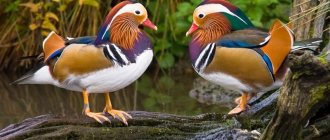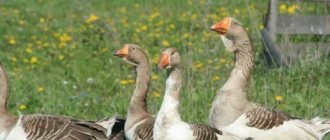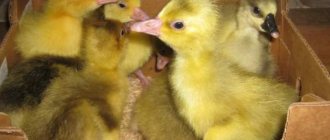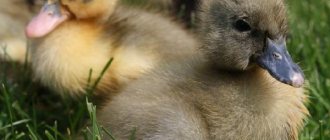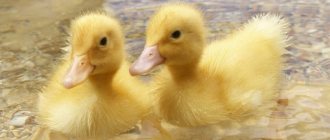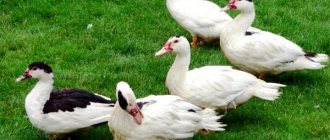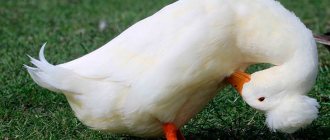Description
These birds differ in external characteristics, behavior, and abilities. Even their usual habitats differ. Poultry farmers note the difference in the nutrition of geese and ducks.
Goose
It is easy to distinguish a goose from a duck. First of all, this concerns the size of the birds. The weight of a goose ranges from 3-4 kg. The body of this species of bird reaches 0.9 meters. When spanned, the wings cover an area whose length between the extreme points reaches up to 1.8 meters.
Accordingly, he has longer legs. With a short shank (spur), the fingers are small. Attached to the middle part of the body. Thanks to these qualities, the goose can quickly swim, run, and move on land. Ganders are larger in size than geese. Over time, they develop a bump of bone structure on their beak.
Geese have a long, beautiful neck, giving the bird a majestic appearance. Unfortunately, this size does not allow it to make deep dives. The beak is the same color as the paws - orange. There is a small nail on its surface. The feathered teeth are sharp. With their help, he easily pulls out plant food from the ground. The goose is a noisy bird. His cackle is loud and trumpet-like. When danger appears, it hisses.
Bird feathers are usually of 3 types:
- white;
- grey;
- grey-brown.
Duck
The duck has an average body weight. Its weight (on the upper scale) is comparable to that of a goose - 2-3.5 kg. The length of the bird is significantly smaller - on average, 0.63 m. The size of wild birds is shorter - it, as a rule, does not exceed 0.5 meters.
This species of bird has short legs, which are more suitable for staying on water than on land. The bird has webbed feet. They grow from the lower third of the body.
The duck walks on land in a peculiar way - it rolls from one side to the other. The neck is short. She allows her to earn her own food. A bird, being on a pond, can easily, almost vertically, plunge into the water. Her tail remains up and her head goes down.
The bird's flat beak helps in searching for food on the water.
The color of ducks is varied. Drakes have bright, eye-catching colors. Females have the following plumage:
- brown;
- gray;
- brown.
They make a variety of loud sounds. But drakes are usually silent, they prefer to hiss.
About geese
Geese and ducks belong to the order Anseriformes, the duck family. The main differences between these birds are in appearance, diet and the sounds they make. Let's take a closer look.
Distinctive features of geese:
- Large build and impressive weight.
- The neck is long, not allowing deep dives.
- Long legs with pronounced webs are equipped with a long tarsus, which contributes to better movement on the ground, fast running and swimming.
- The color comes in two colors: white and gray.
- The beak is small, with a “claw” at the end, and sharp teeth are ideal for pulling grass out of the ground. Geese eat only plant foods.
- The cackle of a goose is trumpet-like, loud. When danger arises, it emits a hissing sound.
Breeding at home
Work plan for hatching chicks in flat-box incubators
Experts provide weighty arguments that make it clear that breeding highly productive Hungarian ducks on your own backyard is affordable and profitable. This is due not only to the production of up to five kilograms of meat from one drake, but also to a relatively good egg production rate.
A female Motley Duck produces at least a hundred eggs per year. There is such an amazing feature as their lack of instinct to hatch eggs.
If breeding a fairly new, but already gaining popularity, breed of Motley Duck is not a seasonal raising of several individuals to obtain meat by the fall, then you will need to build a house for them. The area of the room is calculated based on the number of ducks that are planned to be kept constantly.
Approximately one square meter is enough to accommodate three heads. This is an important condition, since in winter it is easier to provide heat to a small coop.
Wooden duck house with straw bedding
Reviews from people who have already raised Venger ducks indicate that breeding these ducks does not cause much trouble, especially if the necessary care is organized and there are conditions for daily grazing.
Goose in Europe
The question of whether goose or duck tastes better has long been a subject of interest when preparing menus for holiday events.
For a long time, roasted or baked goose was the most popular holiday dish on European tables. Even now, a week before Christmas, this bird is disappearing from the shelves of butcher shops and markets. Many housewives are interested in how to cook a goose, and they order carcasses in advance, very often directly from the farm. The Christmas dish of goose goes back a long way. Legend has it that Queen Elizabeth I ate a goose when she learned that her army had defeated the invincible Spanish Armada. She considered this Christmas dinner a good omen. The tradition then probably spread from England to Germany, where it caught on. But it is more likely that the history of goose is explained by traditions associated with fasting: medieval Christians fasted between Martin's Day (November 11) and Christmas.
Goose became a Christmas dish, probably because of the legend that St. Martin hid among the geese to avoid being found and made a bishop. But, of course, the main reason is that this bird is rich in taste and aroma. And this is what everyone needs after forty days of abstaining from food. And every European housewife knows how to cook goose.
Geese are flying, ducks are flying...
White as snow, stuffed like fur... The answer to this riddle is simple. This is, of course, a goose, which, like the duck, has long been present in the folklore of almost all countries of the world.
The plumage of these birds is truly unique. In addition to the so-called contour feathers, they have down, which creates an air cushion that reliably retains heat. He came out unscathed like a goose - they say about a person who doesn’t care about anything. After all, geese and ducks not only fly, but dive and swim, while remaining dry and not freezing.
People have been using the amazing thermal insulation properties of goose and duck down for a long time. Information about domestic geese and ducks has been known since antiquity. All birds have down feathers, including chickens, but they have nothing in common with the down of waterfowl.
Goose and duck down still remains one of the most valuable natural fillers and insulation materials.
How to distinguish a duck from a goose on the counter
Let's look at how to distinguish a goose carcass from a duck carcass in a store or market.
A duck carcass is smaller than a goose, wide at the bottom, the length of the wings and neck are not pronounced. The smell is refined and sweetish, the skin is thin with a yellowish tint.
It is better to take birds between 6 and 12 months old (you can identify them by the white color of their fat, soft legs and beak). An old specimen will emit an unpleasant odor when cooked. It is recommended to stick to a medium-sized carcass; such a duck is juicier and softer.
A goose is larger than a duck, the carcass is oblong. The skin is thick, elastic, yellowish-pink in color with a specific odor and a pronounced, rough structure. Non-turbid fat and light yellow paws indicate a young age of the individual.
The larger the goose carcass, the better. The meat of small goslings is tough and hard.
The price of a goose is higher than that of a duck.
What do birds of the duck family have in common?
- The body of a goose or duck is wide and voluminous, in comparison with which the head seems small and the neck thin.
- There are quite a lot of cervical vertebrae, from 16 to 25 depending on the species.
- It is distinguished from other waterfowl of the duck family by its wide, slightly flattened beak, framed at the edges by serrated horny plates.
- All members of the duck family have webbed feet, which help them move quickly in the water.
- The dense plumage, after being lubricated on the outside with fat, becomes waterproof, which allows the birds to swim and dive for a long time, after which they can easily take off if necessary.
Does it follow from the commonality of characteristics that a goose and a duck are one and the same?
Despite their external similarity in appearance and lifestyle, these waterfowl differ in a number of less significant characteristics.
Benefit and harm: comparison of duck and goose
The meat of each of these birds is rich in proteins, vitamins and minerals. If you're on a diet, pay attention to the calories: 412 kcal for a goose versus 308 kcal for a duck. Here we are not saying which tastes better, goose or duck. In the end, it all depends on the needs of the body. But in any case, the meat of these birds contains a large amount of calories, which, in combination with drinks with sugar, can lead to excess weight.
But there is also an advantage: meat contains vitamins B, A, iron, phosphorus, potassium and sodium. It is very good to use goose meat for anemia - it increases hemoglobin. Overall, there are many positive aspects: this meat increases power, removes toxins, improves brain function. And duck fat improves metabolism.
Ducks or geese, which is more profitable for meat. Which is more profitable to breed: geese or ducks?
It is good to raise ducks if there is a natural pond near the dacha. Photo: Stanislav Bogomolov
Breeding geese and ducks for dietary meat is quite profitable. And this can be done not only in a village house, but also in the country. A goose gains marketable weight in three to four months, and a duck even faster—in two to three months.
Both birds require, first of all, adequate food, a roof over their heads in the form of a barn, and good care. But there are certain nuances in care. Ducks don't need a lot of space, but they love to swim. It’s good if it is possible to arrange a small pond for them. Geese, on the other hand, require large grassy areas. If there are green lawns near the dacha where birds can be released, they will graze on their own all day long. Ducks are more voracious than geese, but they are less demanding in food. They require grain, succulent food from potatoes, beets, carrots and other vegetables. Additionally, unlike geese, they can eat food waste. In addition to grain and vegetables, geese must be given hay.
Duck meat is fattier than goose meat. However, these birds are bred not only for meat. Goose eggs have valuable properties, but geese lay eggs much less often than chickens. Duck eggs can also be eaten, but they have a specific taste that not everyone likes. In addition, boiled duck eggs should only be eaten hot. When they cool, the whites turn blue and hard.
Both birds are also valuable for their down, but in terms of lightness and ability to retain heat, duck down is inferior to goose down.
Plot
"House. Garden. Vegetable garden" Features and secrets of gardening in the Middle Urals.
What are we frying?
To understand whether goose or duck is tastier, you need to try both of these products. We offer a recipe that is suitable for any bird. First we prepare the carcass. Peel the apples from seeds and cut into slices. Lubricate the goose or duck with the necessary spices and sauces. We stuff the carcass with apples and sew up the belly with thread.
Since ancient times, humans have domesticated some species of birds, including ducks and geese. They have an external similarity, so a novice farmer needs to learn to distinguish between these birds.
Which is tastier – goose or duck? What is the difference between a goose and a duck, what is the difference
Very rarely a feast is complete without meat products. This is a nutritious product that satisfies hunger well and saturates the body with protein. Each type of meat has its own positive and even negative qualities.
Poultry meat is most often present on our table. Chicken or turkey fillet is considered dietary. Goose or duck is traditionally cooked on holidays, for large banquets. There is a difference between these birds, but not so significant.
What tastes better, goose or duck? Let's discuss this issue in this article.
Benefits of duck
The main advantage of duck meat is the presence of Omega-3 fatty acids. The body needs them for good functioning of the heart and brain. Omega-3 makes skin smooth and radiant.
Duck meat has a very high content of vitamin D, so its consumption promotes the absorption of calcium, strengthens bones, muscles and improves immunity. This product also contains vitamins E and B and minerals.
However, the fat content of duck sometimes goes off scale, and the calorie content leaves much to be desired.
Therefore, it must be used with caution
The benefits of goose meat
To understand what is tastier than goose or duck, we also need to talk about the benefits of goose meat. This is a very valuable product. The meat has a slightly sweet taste and contains many vitamins and minerals: zinc, iron, calcium, etc.
Goose meat is rich in fatty acids. It helps normalize the functioning of the stomach, eliminates toxins, diarrhea and heals the spleen. Both products have their positive qualities. Speaking of benefits, it is impossible to determine the difference between a goose and a duck.
Let's look at what the difference in taste is next.
Very often, housewives are faced with the question of what to choose for a traditional holiday dish: goose or duck. Everyone, of course, may have their own preferences. The famous Peking duck is considered a delicacy dish served in the best restaurants. The Chinese value this bird very much. They believe that duck fat is beneficial for the human body.
Duck is cooked with vegetables, and the result is an amazing culinary masterpiece. Goose meat is very fatty. A good bird has up to 40 percent fat. But how can we do without the traditional goose with apples for Christmas? After baking, goose fat permeates the fruit and gives it an incredible taste and aroma.
Therefore, it is very difficult to choose which is tastier, goose or duck.
How to make a choice
Duck meat is very flavorful. But for it to be truly tasty, you need to choose an adult. Only the meat of such a duck develops a special taste and aroma. Goose meat is considered no less nutritious. Its taste is no worse than that of duck. It is better to take a carcass of 6-8 month old geese.
Dishes from goose, duck, turkey and any other bird are delicious if prepared correctly. Therefore, the chosen recipe and cooking technology play a big role here.
It is also very important to choose quality meat. The carcass must be fresh or chilled
The skin should be dry and the meat should not have a specific odor.
To understand whether goose or duck is tastier, you need to try both of these products. We offer a recipe that is suitable for any bird. First we prepare the carcass. Peel the apples from seeds and cut into slices. Lubricate the goose or duck with the necessary spices and sauces. We stuff the carcass with apples and sew up the belly with thread.
Place the bird on its back on a greased baking sheet. Add a little water to the bottom to prevent the carcass from burning. Place the baking sheet in the oven, which we preheat. Goose or duck is roasted for a long time, about 2-2.5 hours. In the process, fat will be rendered, which needs to be poured over the carcass. This will make the meat juicier and more flavorful.
To make the bird cook faster, you can bake it in a special sleeve. When the meat is ready, it must be removed from the oven and the thread tying the belly must be removed. Then place the whole carcass on a dish or cut it into pieces. We put baked apples around them, which turn out very tasty.
Duck meat is more juicy and fatty, but goose has a sweetish taste. To understand whether roasted goose or duck is tastier, you need to try both cooking options. Everyone has their own opinion on this. The taste of meat also depends on the selected additional ingredients, which can give it new notes and a unique aroma.
Cooking a goose or duck is not difficult, but it takes a long time, and there is not a lot of meat in these birds. Therefore, this is more of a festive dish than an everyday one.
Properties of duck and goose meat
Now let's talk about the nutritional properties, appearance and taste of the meat that geese and ducks have.
Duck meat is dark brown or dark red in color and firm. It contains omega-3 acids, vitamins D, E, B and other beneficial substances. Duck meat has a delicate, sweet aroma. Excellent Peking duck is an indispensable dish in Japan. Despite all its advantages, duck should be eaten with caution - the meat is very fatty. Read more in the article “Benefits and harms of duck meat for the body.”
Goose meat is dark in color and has a tart, sweet taste. Rich in fatty amino acids, vitamins and minerals. Goose meat helps the stomach function, prevents the formation of cancer tumors, and is used to increase hemoglobin in the blood. The signature dish is goose with apples, found on New Year's tables.
About ducks and more
Duck Features:
- Light weight, small build.
- The neck is shorter than that of a goose, so the duck can dive deep underwater, ending up in an upright position.
- Short legs are better suited for swimming than walking on land.
- The color of ducks is neutral, but male drakes have bright colors, especially during the mating season, to attract more females.
- The long beak allows you to fish out crustaceans, snails, frogs, algae from the water - what the bird eats.
- The duck quacks loudly, but the drakes are silent and can only hiss.
It is also worth paying attention to the behavior of birds. For example, a duck can eat at night, everything that comes across its path in the water and matches its size.
The goose is not prone to night snacks and does not like to be in the water at night. In general, these birds prefer to live on land and are capable of long-distance flights, while ducks take off very rarely.
Main differences between geese and ducks
- Ducks spend more time in ponds than geese, which can cover their food needs from green grass on coastal pastures.
- In addition to grass, a duck can eat small animals: crustaceans, frogs, small fish and snails, which is not typical for a goose.
- Nocturnal eating is observed only in ducks. Geese usually sleep at night.
- Geese live in pairs. The goose breeds offspring, the gander is constantly nearby, protecting it when a threat arises. The drake duck supports the chosen female only until the offspring hatch, after which it loses interest in family relationships.
- Geese make loud sounds that are coarser in timbre than the more subdued and softer quacks of ducks. When there is potential danger, they hiss loudly and can attack the enemy
How much water should you drink per day and how to drink water correctly
Which down is better: goose or duck down?
The undisputed favorite is considered to be the down of a wild duck - the eider, nesting in the Northern latitudes. It is collected from abandoned nests, which birds line with down they have plucked from themselves. Needless to say, the down of birds that have adapted to raise their offspring on the shores of the Arctic Ocean has truly unique properties. It was never possible to tame these wild ducks. Therefore, eiderdown is very expensive and is more often used for making down jackets than for pillows and blankets. A blanket with such a valuable “filling” is comparable in price to an inexpensive car.
Domestic ducks also produce very high-quality down, but in terms of its characteristics it is significantly inferior to goose down.
Goose down can also be different. The most valuable raw materials are obtained from geese raised in the northern regions. Their down is lighter and warmer than that of their southern relatives. Very high-quality and expensive down is produced, in particular, by the white Siberian goose and Arctic breeds, which rightfully compete with the eider duck.
The characteristics and price of down also depend on the conditions in which the bird was raised. The down of free-grazing geese is always of higher quality and warmer.
Thus, the conditional rating of the value of raw materials obtained from waterfowl is as follows (in descending order):
- eiderdown
- down of northern and arctic geese
- goose down
- duck down
But even here, not everything is simple. For example, musky duck down is valued almost as much as goose down.
Goose and swan, description and differences
These birds are related species. Both species are waterfowl. They prefer to settle near the seashore or swamps. They feed on vegetation.
The description of the swan is of particular interest:
- The bird is quite large. Her body weight ranges from 10 to 23 kg. The smallest subspecies weighs about 6 kg, its wingspan reaches 0.55 m.
- The legs are short and awkwardly waddles when walking from side to side. This sign makes it possible to determine that the bird is waterfowl.
- Swans fly over long distances, on the order of several thousand kilometers.
- The nose of a waterfowl is red. The beaks are colored yellow. A swan's beak always points downwards.
- The neck is curved. Its length allows the swan to get food from great depths.
- There are many types of swans with different colors. There are white, gray, black birds. All of them are listed in the Red Book.
- These waterfowl are quite aggressive. In their territory, they tolerate only a permanent partner and chicks. It is impossible to tame them.
- Before reaching sexual maturity, young individuals are gray or brown on the back, and their belly is white.
How to decorate a pumpkin beautifully
What is the difference between a goose and a swan:
- The second bird looks visually more graceful. Her neck is longer, and it is gracefully arched.
- There is also a difference in the size of the animals. A swan is larger than a goose and, accordingly, weighs more. It has a wingspan of about 2 m.
- Geese are polygamous birds. And swans are a monogamous species.
- You can distinguish a swan from a gander by the sounds they make. The former can hiss, trumpet, or let out something in the form of a scream with their throats, while the latter only hiss and cackle.
Note! Male and female swan are the same size, making it difficult to tell them apart. Ganders are much larger than geese.
Females and males
In both species of birds, it is not difficult to understand where the female is and where the male is. So, you can distinguish ganders from geese by the following characteristics:
- there are no color differences;
- males are larger than females;
- The voice of ganders is abrupt, and that of geese is drawn-out;
- According to the type of behavior, females are calm, and males are aggressive.
One of the obvious differences between ducks and drakes is their behavior. Try releasing a brood of ducks into a pond. Males (drakes) move more and turn their heads. Ducks, on the contrary, do not show emotions and behave calmly on the water. When swimming or flying, the female stays slightly ahead.
There are other distinctive features of ducks and drakes:
- the female is endowed with a rounder head;
- the neck of a drake is wider, and that of a duck is more graceful;
- The male's tail, unlike the female's, has a ring of feathers.
And the duck is in China
While Europeans were domesticating geese, the Chinese turned their attention to ducks.
China, which raises and cooks this bird, has undoubtedly made it its trademark. Peking duck is famous all over the world. The method first used in China for roasting duck was almost the same as that used in the Western world for roasting goose. It was called “sealed oven roast duck.” In principle, the cooking principle was no different from roasting a goose. What could be tastier - goose or duck? Then this question was not asked, but simply prepared. The oven was built from stones and bricks. The walls absorbed the heat and the duck was placed in a heating oven to give it a golden crust.
Wild geese
Most species of wild geese have similar habits. Somewhere in late March - early April they arrive in the northern hemisphere. Depending on the species, to different places: to the northern part of Europe, Greenland, North America, to the tundra and taiga of the northern part of Eurasia. They like to settle in water meadows, not far from bodies of water. They make their nests on the ground. They breed offspring depending on the species: singly, in colonies or in pairs. In one season, offspring are bred once. After migrating from southern countries, most species begin molting. Usually this is June-July. During this period, birds are most vulnerable because they cannot fly. New plumage grows closer to August or September. Birds begin to fly to warm places in the second half of September - early October. Again, depending on the species, birds winter in different places. Mainly on the sea coasts of Eurasia: the coast of the Mediterranean Sea, the Azov and Caspian Seas, in the Black Sea basin. The most important thing for wild geese is the availability of food and an ice-free reservoir. Before migrating, birds gather in flocks numbering from several tens to several hundred. Let's look at what geese look like (photos of different species) below.
Geese hunting
As a rule, geese are hunted in the spring, when the bird returns from its wintering grounds. Hunting season is limited. You can hunt geese for only 10 days. The number of individuals shot is also controlled. They mainly hunt the most common species. These are the gray goose and the bean goose. What these geese look like is discussed above.
The goose is a very cautious bird and immediately flies away when it sees a person. Therefore, there are several ways to hunt geese. The first way is camouflage. You can hide in a trench or in a haystack. It is best to hide in a shelter at night, before the geese arrive at the pasture site.
Another way is stuffed animals. Quite an effective method. You need to place stuffed animals where the geese feed. It is most convenient to hide behind them. The most important thing is that the artificial goose looks just like the real one. It will take about 10-15 pieces. You can lure an approaching flock with a decoy. It must be remembered that electronic decoys are prohibited. Patience and intelligence will be rewarded with excellent prey.
Nesting Features
Reproduction begins only in the 3rd or 4th year after birth. A couple is matched for life. That's why goose fidelity exists. After the flight, the birds immediately form nesting sites, the construction of which begins only when the last precipitation subsides. The goose is engaged in the construction of the nest, while the male is recovering strength after a long flight. To create a nest, any plants are used, including aquatic ones, these can also be branches and sticks. A wild bird necessarily builds a bedding using soft grass.
Nests are built only at a time when the ground is completely free of snow cover.
Birds breed once a year. The nesting period depends on the habitat. Wild geese lay eggs in the spring, less often in the summer. Typically, a wild goose lays up to 10 eggs at a time. The shade of the shell will depend on the breed, but is usually white with small green flecks. Only the female incubates the eggs, covering the eggs with grass litter. Wild geese are very caring mothers. They do not leave the nest unattended for a minute. Even during feeding they do not leave the nest.
https://youtube.com/watch?v=VIDEO_ID
The diet during nesting periods consists almost entirely of aquatic vegetation; birds are especially eager to eat the most tender parts of the plant, which is called pondweed.
How to make a choice
Duck meat is very flavorful. But for it to be truly tasty, you need to choose an adult. Only the meat of such a duck develops a special taste and aroma. Goose meat is considered no less nutritious. Its taste is no worse than that of duck. It is better to take a carcass of 6-8 month old geese.
Dishes from goose, duck, turkey and any other bird are delicious if prepared correctly. Therefore, the chosen recipe and cooking technology play a big role here. It is also very important to choose quality meat. The carcass must be fresh or chilled. The skin should be dry and the meat should not have a specific odor.
Advantages and disadvantages of ducks
Mularda hybrids have strengths that easily cover the main disadvantage - the impossibility of obtaining offspring from them.
The advantages of ducks are:
- large mass;
- low fat content;
- large liver;
- good survival rate;
- ease of care;
- precocity.
The advantages of the hybrid made it popular in various countries in a short time.
In Russia, mullards are not yet grown in such large quantities, which is most likely due to the fact that their cost is higher than other ducks raised for meat.
The price of ducks, depending on where they are purchased, varies significantly. On average, a duckling at the age of 1 week costs about 600 rubles. Adult birds are not sold, as they are not of interest as breeding material.
Appearance and characteristics of the breed
Mulard has a characteristic appearance that prevents it from being confused with other ducks. The feather color is predominantly white . The black spot is necessarily present only on the head. Some individuals may have black feathers on the wings and tail. This phenomenon is due to the fact that ducks with different plumage are crossed.
The size of the duck is significantly larger than that of its parents, which is why some call the breed duck-geese . The body of the bird is dense, elongated, folding. The wings are quite long, fitting well to the body. The neck is strong and quite long. The head is oval and medium in size. The beak is light yellow, flat, elongated. The eyes are always dark. The paws are short yellow-orange in color. The tail is short.
The bird's character is calm. She, unlike the Pekingese breed, is not noisy and clean, and does not throw water near the drinking bowl. These ducks are quite smart, and managing their flock is not difficult. For this reason, mulards can be released into open grazing without fear.
Content Features
Goslings and ducklings begin to be released into the barn and aviary from boxes and brooders in the summer at the age of 2 weeks. As soon as the babies get comfortable, they are left in the house overnight. Such birds can be released onto pastures in the summer from the age of one month.
Bathing containers, if the chicks are kept without a brood hen, are installed in the enclosure only after the babies have feathers. Downy young waterfowl do not yet have subcutaneous fat. And therefore, after bathing, such ducklings and goslings, not being able to hide under the hen, can easily catch a cold and subsequently die.
Description and differences
Ducks and geese are part of the same family of birds. These animals spend most of their lives on the surface of the water, so they have little difference in body structure. To understand this difference, you need to understand the description of each bird species.
What does a goose look like:
- Weight is within 2.5-4 kg. The body length reaches 0.9 m, and the wingspan is 1.8 m. The bird is covered with gray, white or gray-brown feathers. There are specimens with mixed plumage. But such birds are quite rare. White-fronted or white-necked animals are bred on farms.
- The goose's feet are orange, and there is a membrane stretched between the toes. This species is distinguished by its proud posture due to the attachment of the legs to the middle of the body.
- The beak has a small nail, and small teeth are visible inside it. It has the same color as the paws.
- The goose's neck is of medium length.
- The goose is smaller in size than the gander. In males, a bony tubercle grows on the beak.
We invite you to familiarize yourself with Tulips in a polycarbonate greenhouse: forcing technology
The description of the ducks is as follows:
- They are medium in size. Males weigh from 3 to 4 kg, and females - 2-3.5 kg. If the bird is domestic, the body length can reach 0.63 m, and its wild relative grows no more than 0.5 m.
- They have plumage of various colors, but all species have a color “mirror” on the wings. Females are pockmarked, brown or gray, and drakes have bright plumage.
- Almost all types of ducks have yellow feet. They have membranes and are attached to the lower third of the body. Therefore, they have a characteristic manner of movement - when walking, they roll from side to side.
Note! You can find out for yourself how a goose differs from a duck if you carefully observe the birds. But to do this you need to live near a poultry farm or raise animals yourself.
Goose and duck - differences:
- Despite the presence of good flight feathers in birds, geese are capable of long flights, while ducks fly a little worse.
- In appearance, these waterfowl can be easily distinguished by the shape of their nose. In a goose it is pointed, while in ducks it is wide and flat. The beak colors are also different.
- The difference between a goose and a duck can be seen in the sounds they make: the former cackle and hiss if they sense danger, and the latter quack.
- Some farmers try to distinguish these animals by their diet. After all, geese prefer cereals, various berries and seeds, and greens, although some of them consume insects and vertebrates. A duck's diet consists of plants living in water and various spineless animals.
- Geese live in stable pairs. A goose can lay 6-12 eggs. She protects and trains her offspring. Ducks create a family for only one season. They hatch up to 13 eggs and then raise their own ducklings.
- Despite the similarity of habitats, geese prefer to settle by the sea, in swamps, and near lakes. Ducks more often choose rivers with reed thickets and ponds.
It is quite easy to recognize them correctly; you just need the desire.
Benefits of duck
The main advantage of duck meat is the presence of Omega-3 fatty acids. The body needs them for good functioning of the heart and brain. Omega-3 makes skin smooth and radiant. Duck meat has a very high content of vitamin D, so its consumption promotes the absorption of calcium, strengthens bones, muscles and improves immunity. This product also contains vitamins E and B and minerals. However, the fat content of duck sometimes goes off scale, and the calorie content leaves much to be desired. Therefore, it must be used with caution.
Breeding
To breed hybrids, they purchase a hatching egg and an incubator or acquire parent stock. With the incubation method, the air temperature during the first week is maintained at 38–38.2 degrees, after which it is reduced to 37.7 degrees, and a few days before the expected appearance of the chicks - to 37.5 degrees.
In addition to the incubation method, mulards can also be bred using parent stock. The best time for breeding is April. To do this, take one musk drake and several Peking ducks aged 10–12 months. 7–10 days after mating and the start of egg production, eggs are collected.
As soon as the chicks are born, it is recommended to give them a drink with a weak solution of potassium permanganate using a pipette, which will help avoid the occurrence of infectious diseases and eliminate the mortality of the young. The first food for newborns is a hard-boiled egg, which is painted and sprinkled on their backs, from where they happily peck it.
As for lighting, in the first day after the birth of the chicks, the light should be on constantly. Then the duration of the backlight is reduced daily by 50–60 minutes until it reaches 17–18 hours a day. In the first week, old newspapers or paper are used as bedding, replacing it with new paper twice a day, after which it is replaced with straw.
However, these breeding methods are quite labor-intensive. For an inexperienced poultry farmer, they may seem quite complicated, so for beginners it is better to purchase day-old ducklings than to bother with eggs, an incubator and parent birds. The cost of day-old chicks is basically stable and ranges from 240 to 260 rubles per piece.
Many farmers are, of course, interested in how to raise breeds of ducks and geese on their own. In order to get chicks directly on the farm, you need to purchase an incubator. To hatch ducklings, conventional chicken hatching devices are most often used. In this case, a grid with a larger cell is simply installed in the incubator.
Waterfowl usually begin to lay eggs in March. The incubation period for the eggs of such a bird is approximately 29-30 days.
The best breeds of geese
Very extensive selection work was also carried out with such waterfowl. The most popular breeds of geese at the moment are:
- Kholmogory;
- large gray ones;
- Legards.
The weight of drake geese of the Kholmogory breed can reach 12 kg, and that of geese - 8 kg. This bird, among other things, is distinguished by its early maturity, resistance to various kinds of diseases, and calm character. Large gray geese can reach a weight of 9.5 kg by the age of 9 weeks. Moreover, such a bird lays about 60 eggs per year.
Legarda geese with proper diet gain weight of 9-11 kg. This bird is also distinguished by its good early maturity and peaceful character.
